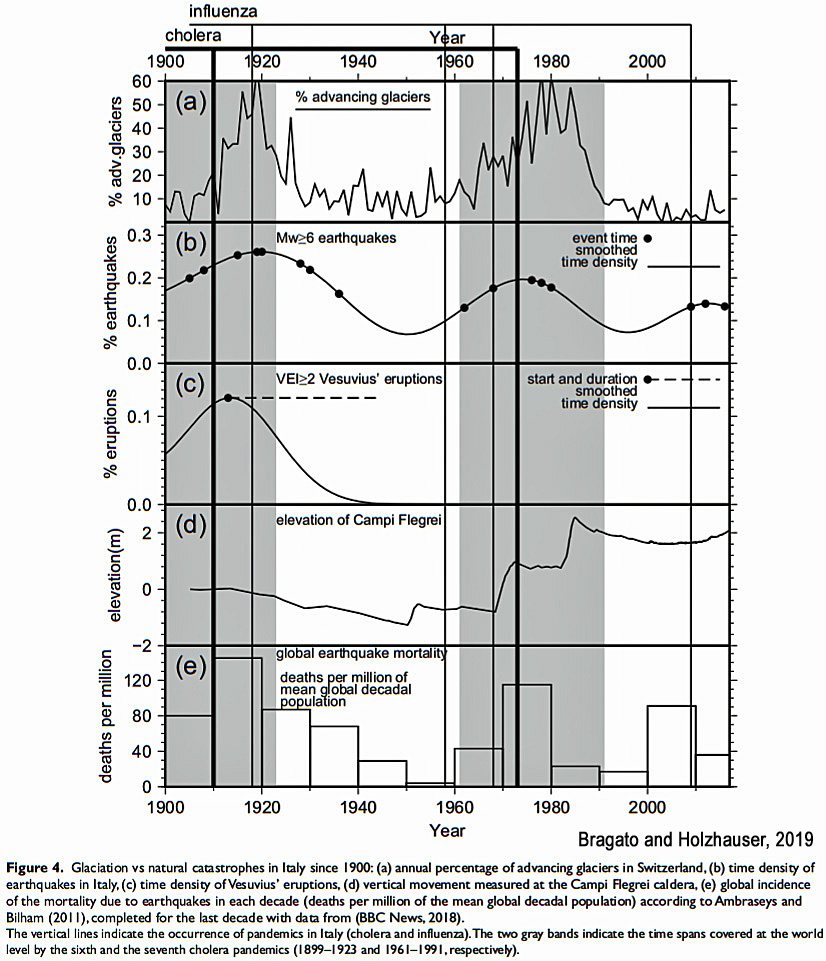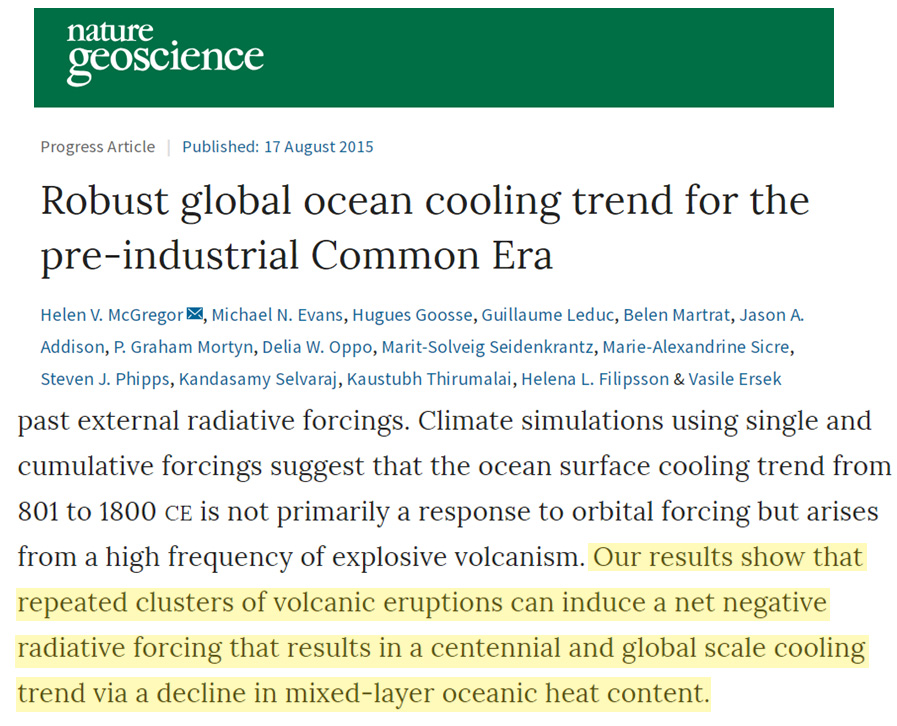Scientists (Bragato and Holzhauser, 2019) find natural catastrophes like tornadoes and earthquakes and pandemics like plague, cholera, and influenza “concentrate in the periods of ice expansion in Europe” whereas periods of economic expansion and a lower incidence of natural catastrophes and pandemics occur during deglaciation phases, or warm periods. Century-scale cooling can be elicited by volcanism.

Image Source: Bragato and Holzhauser, 2019

Image Source: Bragato and Holzhauser, 2019
The conclusion that volcanism can trigger centuries of global-scale cooling – and that the Little Ice Age cooling was forced by explosive volcanism – has also been postulated by McGregor et al., 2015.






Which raises the question: “What causes the cycles in volcanism?”
The answer to what causes cyclic volcanism is what causes cyclic mid-ocean ridge earthquakes and what earth force move the tectonic plates.
Geology has been hiding a paradox. There is no force to move the tectonic plates and the mantel convection theory as a means to move the tectonic plates is a dead theory because….
Suddenly in 1994 there has a 300% increase in mid-ocean ridge earthquakes worldwide. The sudden unexplained change in mi-ocean earthquakes correlated with the temperature changes for the entire period and remained high.
The lack of a forcing mechanism explains why the theory of plate tectonics took so long to be accepted.
http://www.davidpratt.info/tecto.htm
Nitecki et al. (1978) reported that in 1961 only 27% of western geologists accepted plate tectonics, but that during the mid-1960s a “chain reaction” took place, and by 1977 it was embraced by as many as 87%.
Some proponents of plate tectonics have admitted that a bandwagon atmosphere developed and that data that did not fit into the model were not given sufficient consideration (e.g., Wyllie, 1976), resulting in “a somewhat disturbing dogmatism” (Dott and Batten, 198 1, p. 15 1). McGeary and Plummer (1 998, p. 97) acknowledge that “geologists, like other people, are susceptible to fads.”
The driving force of plate movements was initially claimed to be mantle deep convection currents welling up beneath midocean ridges, with downwelling occurring beneath ocean trenches. Since the existence of layering in the mantle was considered to render whole-mantle convection unlikely, two layer convection models were also proposed.
Jeffreys (1974) argued that convection cannot take place because it is a self-damping process, as described by the Lomnitz law.
Plate tectonicists expected seismic tomography to provide clear evidence of a well-organized convection-cell pattern, but it has actually provided strong evidence against the existence of large, plate-propelling convection cells in the upper mantle (Anderson, Tanimoto, and Zhang, 1992).
Many geologists now think that mantle convection is a result of plate motion rather than its cause and that it is shallow rather than mantle deep (McGeary and Plummer, 1998).
https://www.omicsonline.org/open-access/have-global-temperatures-reached-a-tipping-point-2573-458X-1000149.pdf
Namely, increased seismic activity in the HGFA (i.e., the mid-ocean’s spreading zones) serves as a proxy indicator of higher geothermal flux in these regions. The HGFA include the Mid-Atlantic Ridge, the East Pacific Rise, the West Chile Rise, the Ridges of the Indian Ocean, and the Ridges of the Antarctic/Southern Ocean. This additional mid-ocean heating causes an acceleration of oceanic overturning and thermobaric convection, resulting in higher ocean temperatures and greater heat transport into the Arctic [2,3]. This manifests itself as an anomaly known as the “Arctic Amplification,” where the Arctic warms to a much greater degree than the rest of the globe (Table 1) [4,5].
Climate is driven by the ocean, not atmosphere. CO2 warmists appeal to volcanoes when climate fails to correlate with CO2 levels. It’s the “control knob on the control knob”.
Volcanoes are not a factor in climate. Despite their noise and fury, their effect in climate is transient, lasting days or weeks only. No volcano has significantly affected climate in the last century, to the extent of changing the underlying ocean driven multidecadal climate oscillations.
A perfectly adequate explanation exists for climate change – the ocean where 97% – the real 97% – of climate heat energy resides. The 3d ocean circulation system is subject to spontaneous oscillation from nonlinear dynamics (interaction of chaos with feedbacks) and drives climate. The atmosphere provides merely weather.
Magmatic circulation on earth is gradually slowing down as the crust cools. The time when volcanic activity dominated climate cams and went some billions of years ago. Now they’re just an occasional local nuisance.
536, a volcano in Sumatra caused the dark ages…Oh during weak sun cycles, cosmic rays may activate the magma..
Interesting to compare this with Ian Wilson’s analysis of climate vs. lunisolar tidal effects. He suggests that two periods resembling the shaded periods in Figure 4 are times when lunisolar tidal effects influence global temperature anomalies. It seems plausible to me that lunisolar tidal effects can stress the tectonic rifting and subduction zones and cause earthquakes and volcanism as well as causing important changes in oceanic circulation modes.
Re: Wilson’s paper cited above:
“A Luni-Solar Connection to Weather and Climate III: Sub-Centennial Time Scales”
http://astroclimateconnection.blogspot.com/2019/10/a-luni-solar-connection-to-weather-and.html
If you go from the year Mt. Tambora erupted, 1815, to 1816, the year without a summer, all the way to 1917, more than a century, when the Winter of 1917-1918 occurred, including Krakatoa, volcanism has an effect on global temperatures, apparently.
In California, the Redwood forest has stumps that are sixteen feet in diameter. Find out when the Redwood tree was felled, must be a record, then do the dendrochronology, you can do some extrapolating from there.
There are photos with dates out there. Might have to lumber through it all, but the information is there. An entire industry has the history of timber and logging, it is all down on paper. Redwood tree dendrochronology can maybe corroborate volcanism time periods and frequency.
You don’t know until you find out, it can be done.
Just have to go to google earth to see enough land under cultivation to realize that everywhere you go, agriculture is everywhere, olive groves to rice fields, to wheat fields to barley fields to corn fields to soybeans to livestock to produce, it all gets done for you and your convenience.
People are industrious, conscientious and willing when there is a goal which has a purpose and provides more. Won’t make you rich, but who wants that? Lots of hustle and bustle, purdy soon, you’re worn out, you need a rest.
The spirit is willing, but the flesh is weak. Especially after working like a dog.
Lucky for you, you can do it all over again, whatever it is, after a beer session and some sleep. Flip flop, it never stops.
The weather changed from temps at 70 F to 29 at night and 35 during the day. From Fall to Winter in mere hours, there is a half a foot of snow on the ground with three foot drifts in places, the temperature is not warm.
Cold for this time of year, well below average temperatures and far below seasonal daytime highs. 87 is a nice daytime high, 36, not so much.
It’s a mess, not good at all. Soybeans and corn still stand not ready to harvest, it might be a disaster, it don’t look too good.
All in all, it’s bad. Cold weather causes everything to go from bad to worse.
The migration of geese, ducks, cranes is about over. Early last week there were four whoopers directly above and then later on eight more to the west three hundred yards out there, flying less than 500 feet above, got a good view and the whoopers were whooping it up. Sandhill cranes fly as high as they can get. On a clear day, you’ll see them, but barely, they’re flying a mile high and moving along.
Cranes, geese, ducks on the move mean one thing, the weather has changed and the temperatures up north are no longer in the comfort range, zone, so they fly south, for good reason.
There are bald eagles out there, they’re on the move, so you see one or two now and then. You’ll see them standing on the black ground with snow drifts here and there, tough to spot them, the black dirt and snow blend with the bald eagle.
When they’re feeding on a kill, there are ten bald eagles perched in the trees while two or three are on the ground feasting on the freshly killed whitetail. Bald eagles must congregate when there is something to eat.
The doe was standing a thousand feet away wondering what happened. What happens in nature, you just happen to see it at the time.
An eagle with a seven-foot wing span is a force to be reckoned with, when you see one less than a hundred feet from you, you know it is a big bird.
It has been several years now, but I saw an eagle hovering in one spot at less than 500 feet above. As I drove along, I looked up further into the sky, lo and behold, there were two hawks at about 800 feet with an eagle eye on the bald eagle. Hawks will fly in full force towards the bald eagles, the bald eagles fly away and you see them a mile away, then are gone. Hawks are able to drive bald eagles to other happy hunting grounds, they don’t see eye to eye, ain’t gonna happen.
Things you see when you are traveling along or going about your daily tasks.
A good vehicle with an ICE is the way to go, gets you there fast.
There is a lot of life going on out there, air comes in handy to make it all happen. Gotta have the Sun though, what makes it all happen, that and the universe.
The weather changed from warm to cold and it is all white outside the door.
Warm weather is far more desirable.
We can thank Mother Nature, the Sun, the atmosphere’s contents, for what we have here on the Good Earth.
Flora and fauna buried deep in the earth’s crust for 300 million years yield resources such as crude oil.
All from the Sun. As green as it can get, coal and crude oil, the sun’s energy stockpiled and stored for a few hundred million years can’t be all bad. Fossil fuels can and do rise to the occasion, lift the barge and tote the bale.
Weather that is colder than hell is bad.
An igloo or a sod hut, what’s your choice?
Fossil fuels have been the prime choice now for sixteen hundred years and more. The Chinese were burning natural gas 2000 BCE, a long time now.
Fossil fuels provide a post-modern existence that can’t be matched at any other time in history.
Without them, you’ll be hating it in the worst way.
THE dramatic change.
The dramatic change? Modern medicine. Cures for diseases increase survival rates, can’t be denied. No more smallpox, tuberculosis, diphtheria, mumps, measles, polio, maybe even influenza.
Just stop immunizing for communicable diseases, you will have an increase in the number of deaths. Let syphilis happen, trichinosis in the population will be a positive. Let leprosy become pandemic. You want your extinction, let modern medicine wane, become extinct. No need for it, too many people are alive, all because of modern medicine, the culprit.
Extinction Rebellion can go extinct. Let nature take its course. When they do, it’ll be time for a parade, then the celebration. lol